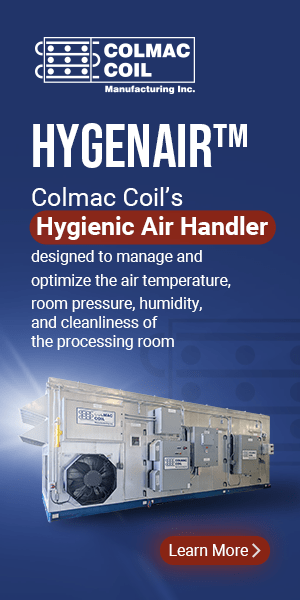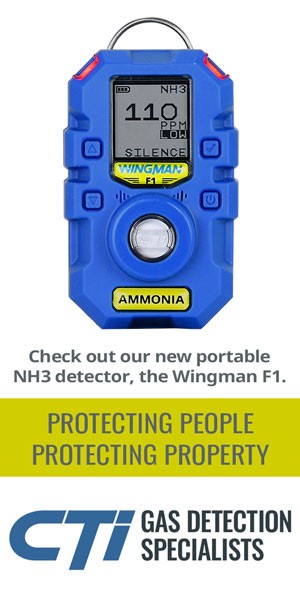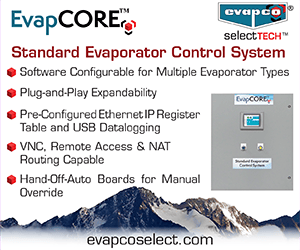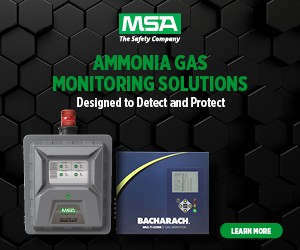IIAR Releases New Standards and Updates
ANSI/IIAR approved standards are reviewed entirely from cover-to-cover, at a minimum, every five- years for periodic maintenance. In addition to the five-year periodic maintenance reviews, a standard may be modified as an addendum. Although addenda are few, IIAR 2-2014 Addendum A is an example of the most recent addendum.
“During our closing forum at the IIAR [2019] annual conference, this last session covered a review of all of our standards,” said Eric Smith, IIAR vice president and technical director.
Smith, along with Tony Lundell, director of standards and safety for IIAR, and Bob Czarnecki, chair of the standards committee and a member of IIAR’s board of directors, provided an in-depth look at the status of each IIAR standard.
IIAR 1: IIAR 1 covers definitions. “It is just easy for terminology reference,” said Czarnecki. He added that IIAR 1 was updated in 2017 and that members of the standards committee are monitoring it for any questions that come up. “They’re noted, and when it is updated in 2022, they will be addressed.”
IIAR 2: IIAR is slated to release Addendum A as an update to ANSI/ IIAR-2014. ANSI/IIAR 2-2014 was a significant rewrite of IIAR 2, making it a standard for safe design encompassing both standard and code language, Lundell said.
“It was the most comprehensive and well-written version of IIAR 2,” Smith said. “It was very good, but after we started using it, we found it needed a few corrections and some provisions addressed for clarity. Also, since the document was so comprehensive, we began approaching code bodies to gain sole adoptation or reference to the IIAR 2, 2014 version. This process pointed out the need for some additional language changes.
Smith said IIAR 2 was accepted by the American Society of Heating, Refrigerating and Air-Conditioning Engineers (ASHRAE) who began referring to IIAR 2 for ammonia systems. “The caveat to that was that in order for ASHRAE to feel comfortable with referring to IIAR 2 for ammonia systems, we needed to cover all ammonia systems, which included absorption systems.”
While the 2014 release didn’t cover absorption systems, the update does. “We have changed the scope to address absorption systems in IIAR 2. We have corrected some minor errors and filled some gaps that were discovered among ASHRAE, IIAR 2 and the codes review,” Smith said.
IIAR 2-2014’s Addendum A has taken about three years to produce and will be released soon. “At this point, ANSI working through their approval of our procedures,” Smith said. “We are awaiting the final ballots from the consensus body.”All approvals should be received by the time the May Condenser issue is published.
Smith noted that IIAR 2-2014’s Addendum A took longer to approve than was originally anticipated because the topic of vessel corrosion allowance was complicated, which he covers in depth on page 36.
IIAR is working on a new CO2 standard, and it has just completed its first public review. “The industry is pushing for low global-warming-potential alternatives, and CO2 falls into that category.”
–Tony Lundell, director of standards and safety for IIAR
After Addendum A is completed, the entire standard will then be opened up for a full cover-to-cover periodic maintenance review.
IIAR 3: This standard pertains to the performance criteria of ammonia refrigeration valves. It was last updated in 2017.
IIAR 4: A periodic maintenance review update to IIAR 4, a standard related to installation, is due next year. Czarnecki said there is a subcommittee working through the document and it is undergoing updates, but there isn’t an expected release date.
IIAR 5: An update to IIAR 5, which addresses the startup of closed-circuit ammonia refrigeration systems, is presently under its five-year periodic maintenance review and is expected to be released later this year. Lundell said the update specifies the minimum requirements for startup and is being revised to concur with the updates to other standards. “IIAR 5 will flow with IIAR 6 and IIAR 7,” he explained.
Czarnecki said the update has completed two public reviews, and the committee has received several comments on public review No. 2 and will be addressing the comments. Should there be any substantive changes as a result of the comments, the standard will go out for a third public review.
IIAR 6: IIAR 6, which is the newest standard, was approved by ANSI on April 16th, 2019.IIAR 6 is a standard for the minimum requirements for inspection, testing, and maintenance of closedcircuit ammonia refrigeration systems. “This standard is now being designed and formatted for publication,” Czarnecki said, adding that IIAR has been working on this standard for years.
Lundell said there are some claims that people within IIAR worked on it for over 13 years. “When I got involved a couple of years ago, I could see they were trying to put their arms around the entire world,” he said, adding that the standard was trying to address every variation of all equipment, and all the means to inspect, test and maintain it. These techniques and equipment continually evolve and are enormous in scope. Further, there are often many ways to accomplish the required tasks. The committee became more focused on the minimum inspections, testing, and maintenance requirements, including the minimum record keeping requirements for continued safe operations and was successful in completing the document.
IIAR 6 is the first comprehensive consensus standard for the inspection, testing, and maintenance of closedcircuit ammonia refrigeration systems, and it provides a path forward for the ammonia refrigeration industry.
“The main issue was determining exactly what the scope and purpose should be,” Smith said, adding that other publications get into the details of how to do maintenance, inspections, and testing. “At first I think there was a struggle on how extensive the standard should be. We determined that what was really needed was to establish the minimum requirements for what is necessary to be done and how often it is to be done.”
The release of IIAR 6 will supersede IIAR Bulletin No. 109. “A lot of facilities have adopted the Bulletin No. 109 checklists (i.e., 109’s) as RAGAGEP,” Lundell said. “Basically the 109s are replaced with Appendix B. A company that has been doing 109s for years can adopt IIAR 6, Appendix B “Ammonia Refrigeration System Safety Checklists” and continue on with them.” Including the checklists in the standard development process has enabled them to be reviewed and enhanced where necessary.
IIAR has also been publishing Bulletin 110, first issued in 1993, predating OSHA and EPA regulations, and the current ANSI public review process. “When bulletins 109 and 110 were written, there wasn’t a broad public review process in place. They were never ANSI approved standards, and were not maintained on a regular schedule,” Smith said. “Furthermore, technology has advanced since then. And they weren’t written in a way that clearly delineates between normative functions and informative functions.”
While Bulletin 110 was a good document for the time in which it was written, it wasn’t drafted with regulatory oversite in mind. Now, the information within Bulletin 110 has been incorporated into IIAR 6, Ammonia Safety Data Book, and several other of IIAR’s standards Smith and Lundell said.
IIAR 7: IIAR 7 Developing Operating Procedures for Closed-Circuit Ammonia Refrigeration Systems, has recently been updated under periodic maintenance. It is intended for those who develop, define, and review operating procedures for ammonia systems, Lundell said. This standard focuses on developing operating procedures for ammonia refrigeration systems and not general operating procedures for all types of chemicals.
An update to the standard recently received ANSI approval. “It was basically putting it into the format we’ve adopted for all of our standards,” Czarnecki.
IIAR 8: Czarnecki said he doesn’t expect many changes to IIAR 8, Decommissioning of Closed-Circuit Ammonia Refrigeration Systems, which is presently open for periodic maintenance. It will be published next year.
IIAR 9: IIAR 9, a new standard for the minimum system safety requirements for existing ammonia refrigeration systems, recently finished its third public review and it is slated to be published this year. “It is going to require owners to review their existing systems and confirm they’re meeting the minimum system safety requirements on these older operating systems,” Lundell said. He added that IIAR 9 also describes the methodology to be used to conduct the safety evaluations.
CO2 Standard: IIAR is working on a new CO2 standard, and it has just completed its first public review. “The industry is pushing for low globalwarming-potential alternatives, and CO2 falls into that category,” Lundell said. He said CO2 can be used in industrial and commercial applications. This standard in development program will be more comprehensive and will include installation, startup, inspection, testing, and maintenance of carbon dioxide refrigeration systems.
Smith said the end-user community and CO2 manufacturing community wanted a standard that would encompass design, installation, maintenance, and operation of CO2 systems, for which there is a wide variety of equipment available. “They felt it would benefit the industry as a whole if a single standard addressed all of these issues,” he said, adding that IIAR is not planning to supersede other design standards, such as ASHRAE 15, or seek code reference to the CO2 standard. “This is an ancillary standard to raise the quality and level the expectations for CO2 systems.”
Czarnecki said the CO2 standard received 133 comments during its first public review and will probably go through a few more rounds of public review before it is published.
Hydrocarbon Standard: IIAR is just beginning work on a hydrocarbon standard. “The standards committee was directed by the board of directors to write the standard. The committee is in the process of getting started on it right now,” Czarnecki said, adding that there isn’t a timeline for completion.
Lundell added that this hydrocarbon standard is intended for natural hydrocarbon refrigerants with no ozonedepleting potential (ODP) and very low global-warming potential (GWP). The standard will include installation, startup, inspection, testing, and maintenance of these systems. It is also intended as a companion standard to ASHRAE and will be scoped to exclude equipment that is listed by nationally recognized listing agencies.












